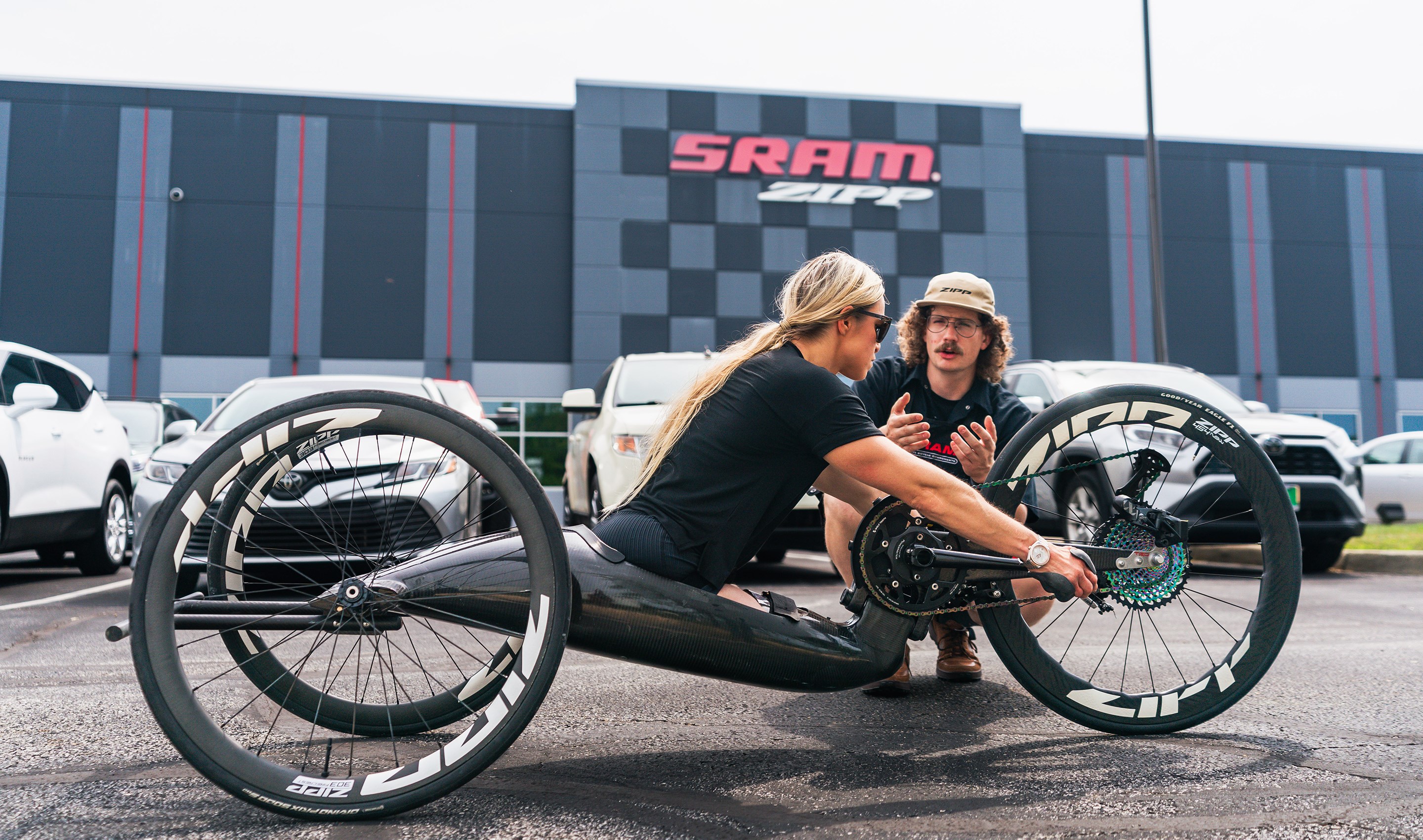Oksana Masters' Gold Mettle
Oksana Masters has 19 Paralympic medals, including nine golds in four disciplines. At the recent Paris Games, she took gold in the Women’s H4/5 Time Trial on September 4 and won the Women’s H5 Road Race the next day. She is one of the most decorated para-athletes ever.
Yet what truly drives Oksana most is her “why”—her choice not to be defined by the horrid circumstances of her early years, to be grateful for the people who love and support her, and to inspire girls with disabilities to discover the power of adaptive sports and aim for the Paralympics themselves.
SRAM congratulates Oksana on her achievements in Paris and is proud to support her efforts. She rides a hand cycle with Zipp wheels and custom SRAM AXS controls. Several weeks before heading to Paris, Oksana visited SRAM Indianapolis to meet with SRAM Race Technician D.J. Fish and to share her story with employees.
I know how bad it can be and what the human body can withstand.
–Oksana Masters

Oksana Masters embodies triumph over seemingly insurmountable obstacles. She was born in 1989 in Ukraine suffering radiation-induced birth defects caused by the Chernobyl nuclear disaster a few years before. Oksana was abandoned to an orphanage, enduring trauma and abuse. She was adopted by Gay Masters, an American, and moved to the United States. In 1997, both Oksana’s legs were amputated above the knee.
“I was first introduced to adaptation sports when I was around 13,” Oksana said. “I was so hesitant to do it because it was called ‘adaptive sports.’ I felt like it was another box for me to be put into. I wanted to play volleyball with my friends in middle school.”
However, she loved rowing and went on to compete in cross-country skiing, biathlon, and cycling. Oksana said her mother supported her throughout, spending retirement savings on expensive prosthetics and other costs. She credits her mom for not only her athletic success but also her survival. When she came to the United States, Oksana was turning 8. She was 36 inches tall and weighed 34 pounds.
“My mom adopted me as a single parent,” Oksana said. “I was diagnosed with failure to thrive. They told my mom I would not make it. I experienced a lot of mistreatment in Ukraine.”

For Paris, SRAM Senior Advanced Development Electrical Engineer Sage Hahn and Fish helped engineer a custom hand grip to provide Oksana with better access to her brake. She switched to disc brakes because they require less force, making it easier with her hand limitations. Oksana also had access to deeper racing rims, such as the 858 NSW and 404 Firecrest wheels she rode in Paris.
“I love racing my bike, being competitive, and trying to get that No. 1 spot. But when I got into sports originally, it helped me heal mentally. It helped me process all the things I didn’t know how to put into words.”
And with every turn of the arms, Oksana keeps writing her remarkable story.
In his own words
A SRAM Tech’s Perspective: D.J. Fish on working with Oksana

Learning about handcycles and Paracycling in general has been awesome. I had an amazing resource in Mike Wehner of the Shirley Ryan Ability Lab in Chicago. He runs their cycling program and welcomed me with open arms into their community. I was able to join in the group rides that they hosted and saw the enormous spectrum of adaptive riders. One thing I noticed immediately is how unique each adaptive bike must be to accommodate the rider's needs. I met riders this year that shift with their head and brake with their elbows!
One of the most fascinating portions of Oksana's bike is the fully customized grips that she uses. They are perfectly molded to her hands based on scans done by Toyota Racing Development and utilize custom light action blip buttons to account for her limited nerve function. Oksana could technically race in a different category as a result of that limitation; however, she chooses to race in a harder one.
Her grit and determination are incredible. It's no surprise that she was chosen as a flag bearer for the United States during the opening ceremony. Before the games Oksana pledged her possible winnings to charities benefiting Ukraine, where she was born. It was a wonderful way to motivate herself, and she referenced how she was doing it so that “little Oksanas” out there would have more opportunities and could see the possibilities of their own success in her actions. It's been an honor and joy to work with her and be a part of her Paralympic journey.
Competition and podium photos © Getty Images
All other photos © Jake Rytlewski


















